Abstract
In this paper we propose a new technique to semantically analyze knowledge flows across countries by using publication and citation data. We start with the identification of research topics produced by a given source country. Then, we collect papers, published by the authors outside the source country, citing the identified research topics. At last, we group each set of citing papers separately to determine the scholarly impact of the actual identified research topics in the cited topics. The research topics are identified using our proposed topic model with distance matrix, an extension of classic Latent Dirichlet Allocation model. We also present a case study to illustrate the use of our proposed techniques in the subject area Energy during 2004–2009 using the Scopus database. We compare the Japanese and Chinese papers that cite the scientific literature produced by the researchers from the United States in order to show the difference in the use of same knowledge. The results indicate that Japanese researchers focus in the research areas such as efficient use of Photovoltaic, Energy Conversion and Superconductors (to produce low-cost renewable energy). In contrast with the Japanese researchers, Chinese researchers focus in the areas of Power Systems, Power Grids and Solar Cells production. Such analyses are useful for understanding the dynamics of the relevant knowledge flows across the nations.








Similar content being viewed by others
References
Blei, M., Ng, A., & Jordan, M. (2003). Latent dirichlet allocation. Journal of Machine Learning Research, 3, 993–1022.
Burrell, Q. L. (1991). The Bradford distribution and the Gini index. Scientometrics, 21, 181–194.
Burrell, Q. L. (1992). The gini index and the leimkuhler curve for bibliometric processes. Information Processing and Management, 28(1), 19–33.
Burrell, Q. L. (2005). Measuring similarity of concentration between different informetric distributions: Two new approaches. Journal of the American Society for Information Science and Technology, 56(7), 704–714.
Burrell, Q. L. (2006). Measuring concentration within and co-concentration between informetric distributions: An empirical study. Scientometrics, 68(3), 441–456.
Frandsen, T. (2004). Journal diffusion factors: A measure of diffusion? Aslib Proceedings, 56(1), 5–11.
Griffiths, T., & Steyvers, M. (2004). Finding scientific topics. Proceedings of the National Academy of Sciences, 101(1), 5228–5235.
Guan, J., & Ma, N. (2007). A bibliometric study of China’s semiconductor literature compared with some other major Asian countries. Scientometrics, 70(1), 107–124.
Hagel, J., Brown, J., & Davison, L. (2009). Measuring the forces of long-term change: The 2009 shift index. New York: Deloitte Development LLC.
Hassan, S., & Haddawy, P. (2013). measuring international knowledge flows and scholarly impact of scientific research. Scientometrics, 94(1), 163–179.
Ingwersen, P., Larsen, B., & Wormell, I. (2000). Applying diachronic citation analysis to ongoing research program evaluations. In B. Cronin & H. B. Atkins (Eds.), The web of knowledge (pp. 373–387). Medford, NJ: Information Today, Inc. & American Society for Information Science.
Jaccard, P. (1901). Étude comparative de la distribution florale dans une portion des Alpes et des Jura. Bulletin de la Société Vaudoise des Sciences Naturelles, 37, 547–579.
Johannes, S., & Guenter, G. (2001). Citation rates, knowledge export and international visibility of dermatology journals listed and not listed in the Journal Citation Reports. Scientometric, 50(3), 483–502.
Liu, Y., & Rousseau, R. (2010). Knowledge diffusion through publications and citations: A case study using eSI-fields as unit of diffusion. Journal of the American Society for Information Science and Technology, 61(2), 340–351.
Luo, X., Hu, Z., Li, Q., Hu, Q., Yu, J., & Tang, X. (2009). Generation of similarity knowledge flow for intelligent browsing based on semantic link network. Practice and Experience, 21(16), 2018–2032.
Luo, X., Yu, J., Li, Q., Liu, F., & Xu, Z. (2010). Building web knowledge flows based on interactive computing with semantics. New Generation Computing, 28, 113–120.
Minka, T., & Lafferty, J. (2002). Expectation-propagation for the generative aspect model. In Proceedings of the eighteenth conference on uncertainty in artificial Intelligence. pp. 352–359.
Rowlands, I. (2002). Journal diffusion factor: A new approach to measuring research influence. Aslib Proceedings, 54(2), 77–84.
Zhou, P., & Leydesdorff, L. (2007). A comparison between the China Scientific and Technical Papers and Citations Database and the Science Citation Index in terms of journal hierarchies and inter-journal citation relations. Journal of the American Society for Information Science and Technology, 58(2), 223–236.
Zhou, P., Su, X., & Leydesdorff, L. (2010). A comparative study on communication structures of Chinese journals in the social sciences. Journal of the American Society for Information Science and Technology, 61(7), 1360–1376.
Zhuge, H. (2006). Discovery of knowledge flow in science. Communications of the ACM, 89(5), 101–107.
Zhuge, H. (2009). Communities and emerging semantics in semantic link network: Discovery and learning. IEEE Transactions on Knowledge and Data Engineering, 21(6), 785–799.
Zhuge, H. (2010). Interactive semantics. Artificial Intelligence, 174, 190–204.
Zhuge, H. (2011). Semantic linking through spaces for cyber-physical-socio intelligence: A methodology. Artificial Intelligence, 175, 988–1019.
Zhuge, H. (2012). Knowledge flow, chapter 5 in the knowledge grid—Toward Cyber-Physical Society (2nd ed.). Singapore: World Scientific Publishing Co.
Author information
Authors and Affiliations
Corresponding author
Rights and permissions
About this article
Cite this article
Hassan, SU., Haddawy, P. Analyzing knowledge flows of scientific literature through semantic links: a case study in the field of energy. Scientometrics 103, 33–46 (2015). https://doi.org/10.1007/s11192-015-1528-3
Received:
Published:
Issue Date:
DOI: https://doi.org/10.1007/s11192-015-1528-3




